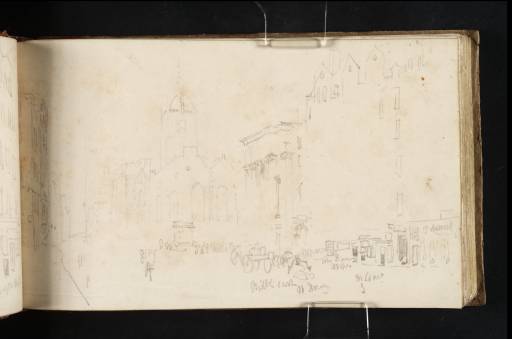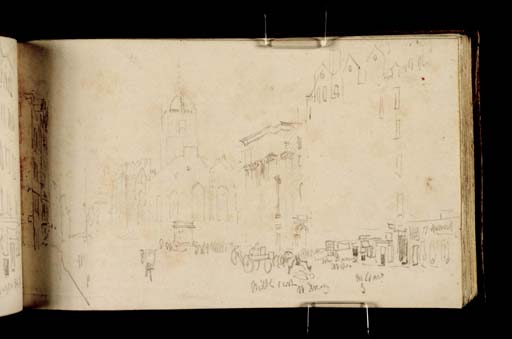Joseph Mallord William Turner High Street, Edinburgh 1818
Image 1 of 2
Joseph Mallord William Turner,
High Street, Edinburgh
1818
Joseph Mallord William Turner 1775–1851
Folio 67 Verso:
High Street, Edinburgh 1818
D13701
Turner Bequest CLXVII 64a
Turner Bequest CLXVII 64a
Pencil on white wove paper, 112 x 186 mm
With the sketchbook inverted, inscribed in pencil by Turner at bottom centre: ‘Milk Cart | [?]W & Pony’; beneath the shops: ‘John & [...]ry | & [...] | M[...] | g’; above shop at right of page: ?‘Horrocks’
With the sketchbook inverted, inscribed in pencil by Turner at bottom centre: ‘Milk Cart | [?]W & Pony’; beneath the shops: ‘John & [...]ry | & [...] | M[...] | g’; above shop at right of page: ?‘Horrocks’
Accepted by the nation as part of the Turner Bequest 1856
References
1909
A.J. Finberg, A Complete Inventory of the Drawings of the Turner Bequest, London 1909, vol.I, p.487, CLXVII 64a, as ‘High Street, Edinbrugh.’.
1979
Andrew Wilton, J.M.W. Turner: His Life and Work, Fribourg 1979, p.426 under cat.1061.
1999
Katrina Thomson, Turner and Sir Walter Scott: The Provincial Antiquities and Picturesque Scenery of Scotland, exhibition catalogue, National Gallery of Scotland, Edinburgh 1999, p.83 fig.21 cat.19.
Drawn with the book inverted is a double-page sketch of Edinburgh High Street (continuing on folio 68; D13702; CLXVII 65). From the Lawnmarket we look towards St Giles’s Cathedral with Tron Kirk behind it to the left, and down the Royal Mile towards Canongate. This drawing and others of the High Street were made in preparation for an illustration to the Provincial Antiquities, for which Turner, in deference to the poet, asked Walter Scott (through Edward Blore) for his preferred view.1
Other views of the High Street in this sketchbook are from the corner of South Bridge looking west (folio 67 verso; D13701; CLXVII 64a) and from just east of St Giles’s looking west (folios 39 verso–40; D13648–D13649; CLXVII 37a–38). A sketch in the Bass Rock and Edinburgh sketchbook (folio 52 verso; Tate D13412; Turner Bequest CLXV 50a) may have been a preparation for the present more finished drawing, which in turn formed the basis of the watercolour of Edinburgh High Street, circa 1818 (Yale Center for British Art, USA).2
A comparison of the sketch and watercolour reveal a close reliance on the sketch, but with the perspective and proportions manipulated. The buildings are the same and the people and their activities are comparable and in the same spirit, if not identical. In shifting the design from a wide to a relatively square format Turner did not crop the sides of the picture, or add anything to the top. Instead he compressed everything in the picture, and made the perspective more acute. Katrina Thomson has also noted that the bends of the street were straightened out and that the street-side of ‘St Giles was cut back to allow an uninterrupted vista of the tenements descending to the Tron Kirk’.3 As well as enabling Turner to fit more into a narrower format, this manipulation also brings St Giles closer to the picture plane and increases the relative size of the objects and people in the foreground. The composition is also tightened and simplified, making for a bolder and more effective image.
The current page shows the south side of the street (right) and some of the north side (left). At the centre of the page is St Giles’s Cathedral with the Tron Kirk behind it to the left. In front of the Cathedral is the corner of Parliament House and between the two is a wellhead surrounded by a small crowd of people, a motif familiar from the sketch of the High Street from the east (folio 64 verso; D13695; CLXVII 61a). Again there is a cart and pony, this time identified with an inscription as a ‘milk cart’. Other inscriptions refer to shops and businesses on the south side of the streets, although these are mainly illegible.
The watercolour contains a wealth of architectural detail, all recorded in this sketch, but with an economy of means using various shortcuts. Both the Tron Kirk and St Giles’s are drawn with very little detail, and it is likely that Turner turned to previously executed sketches to recall their appearance. Parts of Parliament House are shown in detail, but having recorded the main structures and drawn the capitals of the Corinthian pilasters, there was no need for Turner to continue the drawing further, so it is left blank, as is much of the building at the right, presumably because it is recoded in enough detail in the Bass Rock and Edinburgh sketch of the same view (see above). At the street level of these buildings Turner has taken time to show the doors, windows and signs of the various shops. The figures and cart of the sketch are not replicated verbatim in the watercolour, but the sense of bustling activity is retained, although with a greater coherence in the groups and transactions taking place.
Thomas Ardill
March 2008
How to cite
Thomas Ardill, ‘High Street, Edinburgh 1818 by Joseph Mallord William Turner’, catalogue entry, March 2008, in David Blayney Brown (ed.), J.M.W. Turner: Sketchbooks, Drawings and Watercolours, Tate Research Publication, December 2012, https://www


